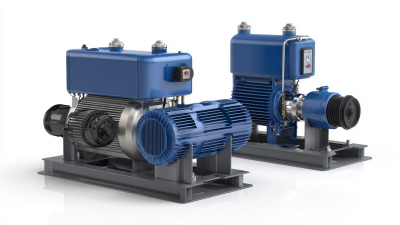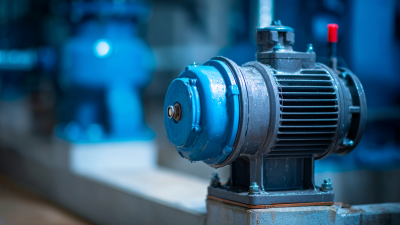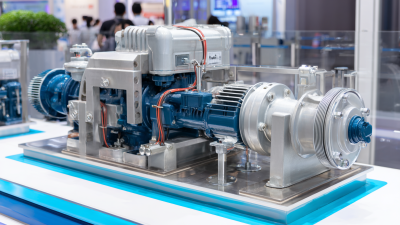2025 Ultimate Guide: What to Expect for Water Pump Prices and Buying Tips
As we approach 2025, the market for water pumps is expected to undergo significant transformations, making it essential for consumers and businesses alike to stay informed about the impending changes. Recent industry reports indicate that the global water pump market was valued at approximately $50 billion in 2020 and is projected to reach over $67 billion by 2025, with a compound annual growth rate (CAGR) of about 6.5%. This growth is driven by rising demand across various sectors including agriculture, construction, and industrial applications, all of which contribute to fluctuations in water pump prices.
Understanding the factors influencing water pump price is crucial for making informed purchasing decisions. Supply chain disruptions, material costs, and technological advancements are just a few elements that can impact pricing. Furthermore, market analysis predicts that advancements in energy-efficient pump designs will provide consumers with more options, potentially affecting the overall market value. With so many variables at play, prospective buyers must equip themselves with knowledge on how to navigate the evolving landscape of water pump prices and make wise investment choices. In this guide, we will delve into the key trends and practical tips to consider when purchasing water pumps in the coming years.

Market Trends in Water Pump Prices: Analyzing the 2025 Landscape
As we look ahead to 2025, understanding the market trends in water pump prices is essential for both industry professionals and consumers. According to the latest forecast by the Global Water Pump Market Report, the industry is expected to experience a compound annual growth rate (CAGR) of 5.2% through 2025, driven by increasing residential and agricultural demands. Factors like technological advancements and sustainability initiatives are also expected to shape the pricing landscape.
To navigate this evolving market, buyers should keep an eye on several key aspects. First, invest in energy-efficient models that, although initially more expensive, can lead to significant savings in operational costs over time. Additionally, monitor raw material prices, as fluctuations can directly impact water pump costs. For instance, a recent analysis revealed that steel prices have surged by 15% in the last year; this trend will likely influence future pricing strategies.
**Tips:** Always compare prices across multiple suppliers and consider seasonal demand variations. Engaging with industry experts can also provide insights into the best time to purchase. Lastly, ensure that you evaluate warranty and service agreements, as these can add significant value to your investment in water pumps.
2025 Ultimate Guide: What to Expect for Water Pump Prices and Buying Tips
| Pump Type | Price Range (USD) | Common Applications | Market Trend (2025) |
|---|---|---|---|
| Submersible Pump | $150 - $1,500 | Dewatering, Well Water | Stable Growth Expected |
| Centifugal Pump | $500 - $5,000 | Industrial, Agricultural | Increasing Demand |
| Diaphragm Pump | $300 - $3,000 | Chemicals, Water Treatment | Moderate Growth |
| Gear Pump | $200 - $2,000 | Viscous Liquids, Oils | Slow Growth |
| Piston Pump | $400 - $4,000 | High Pressure Applications | Steady Demand |
Key Factors Influencing Water Pump Prices: Supply Chain and Material Costs
When considering the prices of water pumps in 2025, understanding the key factors influencing these costs is essential. Supply chain disruptions, which have been a significant issue in recent years, are likely to continue affecting prices. According to the latest report from the Global Water Pump Market Analysis (2023), logistical challenges and increased shipping costs can add up to 30% to the final price of water pumps. Manufacturers are grappling with delays and shortages in critical components, which in turn drives up production costs and, subsequently, retail prices.
Moreover, material costs play a crucial role in determining water pump prices. As outlined in the Raw Materials Institute’s 2022 report, prices for metals like stainless steel and cast iron have risen by 15% and 25%, respectively, due to heightened demand and limited availability. This surge in material costs directly impacts pump manufacturing expenses, which are projected to rise as manufacturers look for alternatives or adjust their pricing strategies to account for these changes. Therefore, both supply chain dynamics and fluctuating material costs should be carefully monitored by potential buyers to make informed purchasing decisions in 2025.
Top Water Pump Types for 2025: Performance and Price Comparisons
When considering water pump options in 2025, it's essential to understand the various types available on the market, each offering distinct performance features and pricing structures.
 Centrifugal pumps remain a popular choice due to their efficiency and straightforward design. They are well-suited for applications requiring a steady water flow, such as irrigation and residential water supply.
Prices for centrifugal pumps typically range from $100 to $600, depending on the capacity and brand, making them an accessible option for many users.
Centrifugal pumps remain a popular choice due to their efficiency and straightforward design. They are well-suited for applications requiring a steady water flow, such as irrigation and residential water supply.
Prices for centrifugal pumps typically range from $100 to $600, depending on the capacity and brand, making them an accessible option for many users.
Submersible pumps, on the other hand, have gained traction for their versatility and effectiveness in deeper water sources. They are ideal for applications such as groundwater extraction and wastewater management. While generally more expensive, with prices often between $300 and $1,200, their robust design and better performance can justify the investment for those needing consistent and reliable water movement.
Additionally, the newly emerging solar-powered pump systems are becoming increasingly popular due to their eco-friendliness and cost-saving potential, with prices starting around $400 and varying based on capacity and technology used.
Buying Tips for Consumers: Making Informed Decisions on Water Pumps
When considering the purchase of a water pump, informed decision-making is crucial for consumers. The first step is to clearly understand your specific needs. Factors such as the type of fluid you need to move, the required flow rate, and the total head pressure will dictate the type of pump suitable for your situation. Additionally, consider the pump’s power source—electric, solar, or gas—as this may influence the overall long-term costs. Researching various brands and models can provide insights into the reliability and efficiency of different options, helping consumers avoid potential pitfalls.
Furthermore, it's essential to understand the market landscape as it pertains to water pump prices. Due to fluctuating raw material costs and technological advancements, prices can vary widely. Being aware of seasonal trends and the general economic climate can also aid in timing your purchase for the best deals. Look for warranties and after-sales support, as these factors can significantly enhance your investment. By taking the time to gather information and assess options, you can ensure that your choice of water pump meets your needs while also staying within your budget.
Future Predictions for Water Pump Demand: Insights from Industry Experts
As we look towards 2025, industry experts predict a significant shift in water pump demand driven by technological advancements and environmental concerns. Increased awareness of water conservation and efficiency has prompted both consumers and industries to seek more reliable, durable, and energy-efficient pumping solutions. As a result, we can expect the market to see a surge in demand for innovative products that not only meet current standards but also anticipate future environmental regulations.

When considering the purchase of a water pump, it’s essential to conduct thorough research. Firstly, focus on the pump's energy efficiency rating; a higher efficiency can lead to cost savings over time. Secondly, evaluate the warranty and support services provided by the manufacturer, as reliable customer service can be invaluable when issues arise. Additionally, compare different brands and models, keeping in mind the specifications that best meet your needs, rather than opting for the lowest price.
As we approach 2025, market dynamics will likely influence pricing. Keeping an ear to the ground on industry trends can provide insights on when to buy. Additionally, consider purchasing off-season to take advantage of potential discounts as demand fluctuates throughout the year.
Related Posts
-

Exploring the Best Deals on Water Pump Prices for 2024 Essentials
-

The Essential Guide to Choosing the Right Submersible Pump for Your Needs
-

The Ultimate Guide to Understanding How Water Pumps Transform Our Daily Lives
-

Top 10 Dirty Water Pumps: Efficient Solutions for Heavy-Duty Water Removal in 2023
-

Exploring Water Pump Innovations for Home Use at the 2025 China Import and Export Fair
-

Top 5 Drainage Pumps for Efficient Water Removal: A Comprehensive Buyer’s Guide
